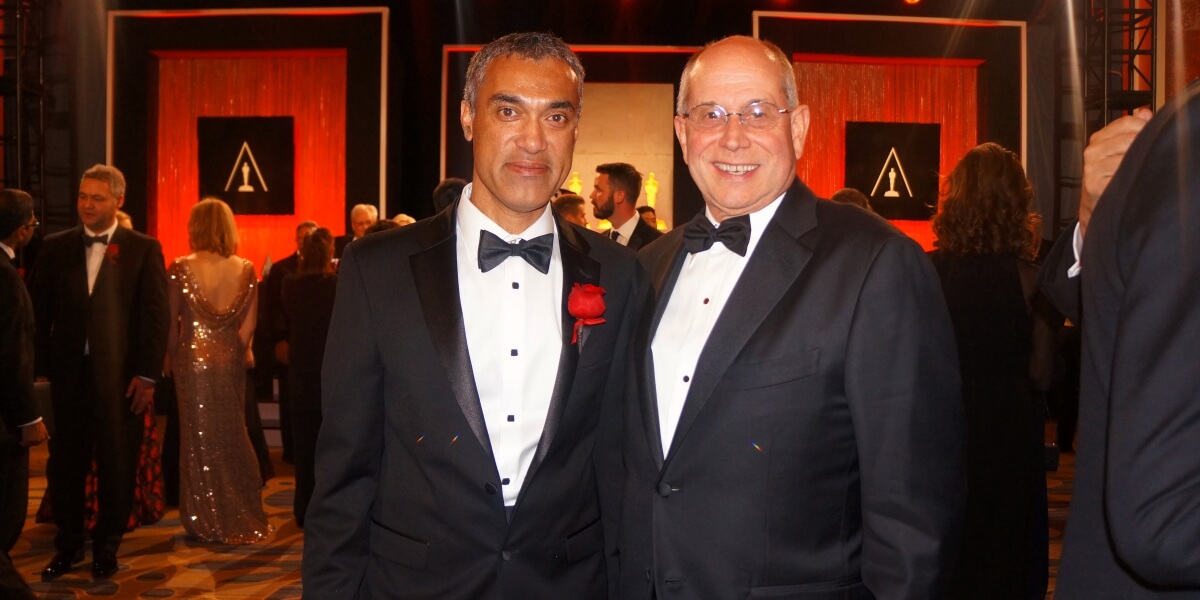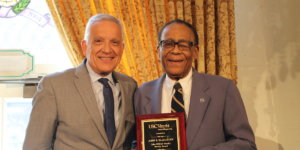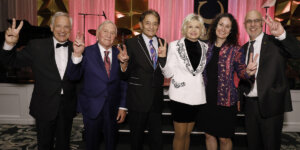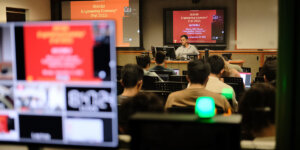
Oscar winner Parag Havaldar and Chairman of the Science and Technology Council of the Academy of Motion Pictures Ray Feeny pose for a picture at the Scientific and Technical Achievement Awards on Feb 11, 2017. Photo courtesy of Parag Havaldar.
Parag Havaldar, ’96 Ph.D. computer science and adjunct professor in the Department of Computer Science was awarded an Academy Award in Technological Achievement at the 2017 Academy of Motion Picture Arts and Sciences Scientific and Technical awards on February 11 in Beverly Hills.
Havaldar was honored for the original development of an expression-based facial performance-capture technology in association with Sony Pictures Imageworks. In doing so, he became only the sixth Indian to win the highest honors in Hollywood and the second USC Viterbi computer science alum to do so in the last 5 years. Matt Cordner, B.S. ’97, won an Academy Award for technical achievement in 2012.
For 12 years, Havaldar was the fulcrum of research and development teams on Hollywood hits like The Polar Express, Monster House, Beowulf, Watchmen, Alice in Wonderland, and The Amazing Spiderman series, working with some of the most legendary trailblazers in Hollywood such as Academy Award winner Robert Zemeckis and two-time Academy Award nominee Tim Burton.
In each film, he toyed with formulas and mechanisms that set up animation rigging and image capture for facial expressions — the skeleton that animators and filmmakers then use to paint vibrant photorealistic, or, in the case of Monster House, exaggerated depictions of actors’ faces in surreal worlds.
“With their outstanding, innovative work, these technologists, engineers and inventors have significantly expanded filmmakers’ creative choices for moving image storytelling” Academy Award Winner Ray Feeney
This process is what transports the audience from a theater into the world of the movie, making the impossible real. It is how a house can turn into a face and its door a mouth that sucks children in. It’s how Alice can fall into a world of monsters and plants and Tweedle Dee and Tweedle Dum. As distorted as it may seem, it all feels real. This sort of magic is not easy to execute.
“Every project is different in its requirements and different in its technological needs,” Havaldar said. “I can say with a great deal of happiness that working on set was the most important part of my experience. I got to work with the directors and received their input.”
This sort of closely collaborative experience made the new technology flourish for the creative hand, an aspect of the software that made it feasible in the field of special effects indefinitely.
“With their outstanding, innovative work, these technologists, engineers and inventors have significantly expanded filmmakers’ creative choices for moving image storytelling,” said Ray Feeney, Academy Award winner and chair of the Scientific and Technical Awards Committee.
Other researchers build off of Havaldar’s data and software to create advancements in visuals, cementing into even more fascinating effects that blends reality with animation to the point where they appear indistinguishable.
“If you are in the artistic side of things, understanding technology and how to harness it is very crucial,” Havaldar said. “Similarly, coming from the technology side, you have to understand artistic requirements. Only then can you write software or processes that can be used by artists to create the art form that they want.”
From Then, to Now
The Oscar caught Havaldar completely by surprise. He had shifted from working in the movie industry to gaming in the past couple of years, so he didn’t exactly have his eyes set on an Oscar. In fact, he had accidentally left his phone in the car the night the announcements were made to the nominees. He had come across it the following morning in the form of a radio announcement highlighting the technological achievement in the movies he had worked on. After quickly returning home to look up the information, he realized that he had actually won an Oscar.
The Next Adventure in Storytelling
As much as he is proud of his accolades in film, his next step is a step into gaming at Blizzard Entertainment.
“With the growing modes of interaction in gaming, from virtual reality to immersive storylines that deal with a lot more than a point and shoot clicker, games are set to overlap or even overtake movies,” Havaldar said.
Whatever the medium, Havaldar hopes to continue creating new tools for storytelling.
“Stories are all about experiences, experiences are all about characters, or rather actors, and actors communicate through facial expression. So being able to capture that has really been a rewarding experience for me.”
Published on February 26th, 2017
Last updated on March 10th, 2017












